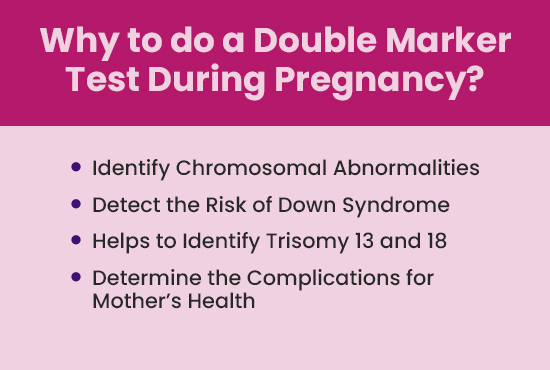
Second Trimester Markers
Pregnancy is a journey filled with excitement, anticipation, and sometimes, concerns. As you progress through each trimester, ensuring the health and well-being of your baby becomes a top priority. The second trimester, often referred to as the "golden period," is when many women feel their best. However, it's also a crucial time for screening certain chromosomal abnormalities in the developing fetus. Understanding the significance of second trimester markers can help you make informed decisions for your baby's health.
What Are Second Trimester Markers?
Second trimester markers are specific indicators that can be detected through ultrasound and blood tests during the second trimester of pregnancy. These markers can provide valuable information about the likelihood of certain chromosomal abnormalities, such as Down syndrome (Trisomy 21), Trisomy 18, and neural tube defects.
Why Are These Markers Important?
Identifying potential chromosomal abnormalities early on can help you and your healthcare provider plan the best course of action for your pregnancy. Early detection allows for a range of options, from further diagnostic testing to specialized care during pregnancy and after birth. It’s about giving you peace of mind and ensuring that you’re prepared for any outcome.
What are Ultrasonographic Markers for Chromosomal Abnormalities?
One of the most common methods for detecting chromosomal abnormalities is through ultrasound. During the second trimester, your healthcare provider may recommend an ultrasound to check for ultrasonographic markers for chromosomal abnormalities. These markers include specific physical features or measurements that may indicate a higher risk for conditions like Down syndrome.
Common Ultrasonographic Markers are:
- Nuchal Fold Thickness: An increased thickness in the fold at the back of the baby’s neck may suggest an increased risk of Down syndrome.
- Absent or Hypoplastic Nasal Bone: A missing or underdeveloped nasal bone can be another indicator of chromosomal abnormalities.
- Echogenic Intracardiac Focus: A bright spot seen in the heart during an ultrasound, which could be linked to a higher risk of Down syndrome.
These markers don’t provide a definitive diagnosis but rather indicate the need for further testing. Your doctor will explain these findings and may suggest additional tests if necessary.
The Role of Blood Tests: Double and Quadruple Marker Tests
In addition to ultrasound, blood tests like the double marker test and quadruple marker test in pregnancy are essential tools for assessing the risk of chromosomal abnormalities.
Double Marker Test in Pregnancy
The double marker test in pregnancy is typically done between 10 to 14 weeks but may also be considered in the early second trimester. This blood test measures two specific proteins in your blood—free beta hCG and PAPP-A. The levels of these proteins, combined with your age and other factors, can indicate the likelihood of chromosomal abnormalities, particularly Down syndrome.
Quadruple Marker Test in Pregnancy
The quadruple marker test in pregnancy is usually performed between 15 to 20 weeks. This test measures four substances in your blood: AFP, hCG, Estriol, and Inhibin-A. Like the double marker test, the results are used to calculate the risk of chromosomal abnormalities. The quadruple marker test provides a more comprehensive assessment and is particularly useful if the double marker test was missed or if additional confirmation is needed.
Non-Invasive Prenatal Testing (NIPT): A Modern Approach
For those seeking a more advanced screening option, non-invasive prenatal testing (NIPT) offers a highly accurate method for detecting chromosomal abnormalities. NIPT analyzes small fragments of fetal DNA in the mother’s blood to screen for conditions like Down syndrome, Trisomy 18, and Trisomy 13.
What are the Benefits of Non-Invasive Prenatal Testing?
- High Accuracy: NIPT has a detection rate of over 99% for certain conditions, making it one of the most reliable screening tests available.
- No Risk to Baby: As the name suggests, NIPT is non-invasive, meaning there’s no risk to the baby, unlike some diagnostic tests that require amniotic fluid or placental tissue samples.
- Early Detection: NIPT can be performed as early as 10 weeks into pregnancy, providing early reassurance and ample time for decision-making.
While NIPT is more expensive than traditional screening methods, many find the peace of mind it offers to be well worth the investment.
What to Do If a Marker Is Detected?
Finding out that a second trimester marker has been detected can be overwhelming. However, it’s important to remember that these markers do not mean that your baby has a chromosomal abnormality—they simply indicate a higher risk. Your healthcare provider will guide you through the next steps, which may include further testing, such as amniocentesis or chorionic villus sampling (CVS), to obtain a definitive diagnosis.
Making Informed Decisions with Garbh
At Garbh, we understand that the health and well-being of your baby are your top priorities. Our expert team is here to support you every step of the way, offering comprehensive prenatal screening options, including ultrasonographic markers for chromosomal abnormalities, the double marker test, the quadruple marker test, and non-invasive prenatal testing. We’re committed to providing you with the information and care you need to make informed decisions for your pregnancy.
Your pregnancy journey is unique, and so are your needs. By understanding the importance of second trimester markers and the various screening options available, you can take proactive steps to ensure the health of your baby. At Garbh, we’re here to help you navigate this journey with confidence, offering the expertise and care you deserve. Contact us at 0172-450692 or +91 7087204818 to book an appointment with us.
FAQs
What are second trimester markers?
Ans. Second trimester markers are indicators detected through ultrasound or blood tests that can suggest an increased risk of chromosomal abnormalities in a developing fetus.
What is the double marker test in pregnancy?
Ans. The double marker test is a blood test performed during the first or early second trimester that measures specific proteins to assess the risk of chromosomal abnormalities.
How accurate is non-invasive prenatal testing (NIPT)?
Ans. NIPT is highly accurate, with a detection rate of over 99% for certain chromosomal abnormalities, making it one of the most reliable screening tests available.
When is the quadruple marker test in pregnancy performed?
Ans. The quadruple marker test is typically performed between 15 to 20 weeks of pregnancy to assess the risk of chromosomal abnormalities.
What should I do if a second trimester marker is detected?
Ans. If a marker is detected, it’s important to follow up with your healthcare provider for further testing and guidance. These markers indicate a higher risk, not a definitive diagnosis.

